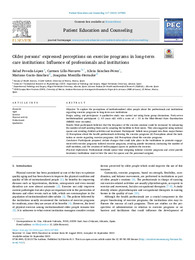Please use this identifier to cite or link to this item:
https://hdl.handle.net/11000/37938Full metadata record
| DC Field | Value | Language |
|---|---|---|
| dc.contributor.author | Poveda López, Salud | - |
| dc.contributor.author | Lillo-Navarro, Carmen | - |
| dc.contributor.author | Sanchez-Perez, Alicia | - |
| dc.contributor.author | Gacto-Sánchez, Mariano | - |
| dc.contributor.author | MONTILLA-HERRADOR, JOAQUINA | - |
| dc.contributor.other | Departamentos de la UMH::Patología y Cirugía | es_ES |
| dc.date.accessioned | 2025-11-07T08:59:35Z | - |
| dc.date.available | 2025-11-07T08:59:35Z | - |
| dc.date.created | 2023-12 | - |
| dc.identifier.citation | Patient Education and Counseling. Volume 117, December 2023, 107985 | es_ES |
| dc.identifier.issn | 1873-5134 | - |
| dc.identifier.issn | 0738-3991 | - |
| dc.identifier.uri | https://hdl.handle.net/11000/37938 | - |
| dc.description.abstract | Objective: To explore the perceptions of institutionalised older people about the professionals and institutions regarding exercise programs in long-term care institutions Design, setting, and participants: A qualitative study was carried out using focus group discussions. Forty-seven institutionalised participants (≥ 65 years old) with a score of > 23 in the Mini-Mental State Examination (MMSE) were recruited. Results: Most participants believed that the frequency of the exercise sessions could be increased by enhancing the number of staff assisting them and by adapting the facilities to their needs. They also suggested using outdoor spaces and avoiding childish activities and treatment. Participants’ beliefs were grouped into three major themes (i) Perceptions about the health professionals delivering the exercise programs (ii) Perceptions about the institution or centre regarding exercise programs; (iii) Perceptions about the exercise programs. Conclusion: Participants proposed certain changes that could take place in the institutions to promote engagement with exercise programs: tailored exercise programs, avoiding puerile treatment, increasing the number of staff members, and the creation of well-equipped spaces to perform the exercise. Practical implications: Professionals should spend time designing tailored exercise programs and avoid puerile treatment. Institutions must review the need for spaces and the personnel assigned. | es_ES |
| dc.format | application/pdf | es_ES |
| dc.format.extent | 6 | es_ES |
| dc.language.iso | eng | es_ES |
| dc.publisher | Elsevier | es_ES |
| dc.rights | info:eu-repo/semantics/openAccess | es_ES |
| dc.rights | Attribution-NonCommercial-NoDerivatives 4.0 Internacional | * |
| dc.rights.uri | http://creativecommons.org/licenses/by-nc-nd/4.0/ | * |
| dc.subject | Aged | es_ES |
| dc.subject | Exercise | es_ES |
| dc.subject | Physical activity | es_ES |
| dc.subject | Professionals | es_ES |
| dc.subject | Qualitative | es_ES |
| dc.subject.other | CDU::6 - Ciencias aplicadas::61 - Medicina | es_ES |
| dc.title | Older persons’ expressed perceptions on exercise programs in long-term care institutions: Influence of professionals and institutions | es_ES |
| dc.type | info:eu-repo/semantics/article | es_ES |
| dc.relation.publisherversion | https://doi.org/10.1016/j.pec.2023.107985 | es_ES |

View/Open:
Older persons’ expressed perceptions on exercise programs in long-term care institutions Influence of professionals and institutions.pdf
442,39 kB
Adobe PDF
Share:
.png)
